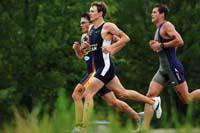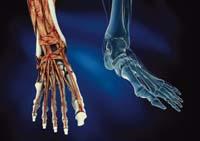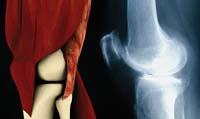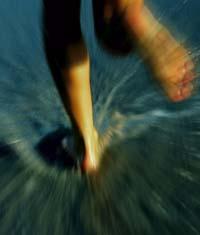Not running

Between both sports there is a great biophysical difference. And it is that the judges of the march use one of the characteristics of this activity to accept the march of a participant: walking involves always having a leg in contact with the ground, and that is the main condition of the athletic march: the athlete cannot have both legs simultaneously in the air. That would be running and running is forbidden.
Biophysicists also use the characteristic of having or not legs in the air to distinguish between walking and running. The man always has a leg when he walks on the ground. Also two-legged animals. However, with four-legged animals the question was not so clear. The horse, for example. When he runs (in gallop) he puts all four legs at the same time. But it was very long to become aware of it. Until the development of photography there was an intense debate around this issue.
Despite two or four legs, the only difference between walking and running is not the story between legs and earth, but the movement of the whole body. Moreover, it is not a purely mechanical question, but the influence of many factors.
One of these factors is energy. It is a very important factor, you can say that it is one of the most important. Therefore, one of the first steps of biophysicists to study the basis of locomotion is the study of energy.
Reverse pendulum

From an energetic point of view, walking and running are totally different. When walking, one leg pushes the floor as the other advances. At a given time there are two feet on the ground and the cycle is repeated with the second leg. In this movement, the mass center of the body behaves like a reverse pendulum, that is, the mass center follows the path of a pendulum that is turned around: the person is at the highest point with one leg on the ground and the other in the middle of the passage, while when he has both feet on the ground, the mass center is at the lowest point. At the highest point, the body presents an energy potential thanks to gravity, reaching maximum speed at the lowest point.
There is a rate of energy flow rate from which the instantaneous potential energy is converted in the current kinetic energy. The energy is not preserved at 100%, among other things by the bending of the knees, but the human being retains approximately 60% of the energy thanks to the reverse pendulum.
When you run something else happens: the mass center of the body is jumping and in every step it is made to throw. At the highest point, both legs are at the same time in the air. At this time, the mass centre presents maximum heights and speeds. Once the foot is placed on the ground, much of the energy in the air is lost. The entire leg (and body) should behave like a spring to harness elastic energy and supply energy to the next jump. Therefore, the energy cost of running is very high.
Why does man run? Of course, to move at high speed. Despite the high energy consumption, it can escape or run over. In many cases, walking does not give you that option, the activity is too slow. Despite the speed, the human being must run to reach maximum speed.
In other species the same thing happens, although they separate the energy in another way. For example, a lizard has the best energy transfer at low speed, at much lower speed than a sheep. It involves many factors, such as body size, shape and presence or not of elastic tissues. In the case of a single species, the energy use also varies with the age of the grain. And so the speed of shifting from gear to stroke also changes.

Running
The question is when the animal makes the transition between the two; depending on what stops walking and starts running. It has much to do with energy, but it is not an absolutely decisive factor.That said: from an energetic point of view, moving slowly is better than running. That is, running very slowly spends more energy than doing it slowly. But from a certain speed the opposite happens, running is the best way to spend less energy.
That is why biophysicists believed that energy is the main factor for moving from walking to running. If a walking animal starts to walk faster and faster, at a given moment it stops walking and starts running. When? Logically, when you have to consume less energy than to run. Logically it is so, but in reality it is not so. Experiments yielded another result: animals --human beings - begin to run before this happens. Horses, for example, make this change long before.
The absolute speed of transition varies from species to species, but there is a similar characteristic in all species. It is easily understood in animals with two legs. When walking, on the reverse pendulum, the mass center of the body has a circular movement in which a centripetal force intervenes. Centripetal force is the force from the hip to the ground base.

In theory, two-legged animals stop walking at a speed equivalent to that centripetal force and the gravitational force on the body. But in practice it is not so, the transition occurs at a lower speed. (In four-legged animals the same thing happens, but with a more complex biophysical model).
To quantify the relationship between forces, biophysicists use the ratio between centripetal and gravitational force, i.e. the ratio between the two. The result of this operation is called the Froude number. In short, animals start to run when the number of Froude is less than one.
Additional factors
The Froude number helps to know at what speed the transition occurs, but does not explain why. Why do they stop walking when running is more 'tired' than he?
Nobody knows the answer, because locomotion is a very complex activity, but they know that the key is in that complexity. The more features you take into account the better the variations of energy in locomotion. It is impossible to fully study locomotion, all characteristics and movements, but approaches can be made. The same simple models can be improved.

On the other hand, running is even more complicated. In the simple model, the movement is due to a spring. What springs? Ankles, knees and hips. Joints. The reaction of this movement on the ground varies greatly from place to place. It is not the same to run on sand, grass or cement. (The march also varies depending on the soil, but the variation is less.) The human being changes the behavior of the joints according to the soil. Man mainly changes the contact time of the leg with the ground and the distance at which the center of masses moves vertically.
Close view
The energy balance can be improved even more considering not only the general movements, but also the contributions of the components. In short, the movement of the body is the coordination of many small components that influence the transmission and consumption of energy.
But not all to the same extent. Bones maintain the body's structure, but do not cause movement. Muscles do, force and transmit that strength to the joints. From the point of view of physics, the muscles affect a moment to the joints. This means that they transmit a certain amount of force in a certain direction. Therefore, those who analyze locomotion study joint dynamics.

The dynamics should be analyzed in three joints: the ankle, knee and hip. In locomotion, all three participate at the same time, but also in different sizes.
When walking, the ankle works the most. For example, when there is only one leg on the floor, all the ankle muscles work. Walking does not consume much energy, but most of what you consume is used on the ankle.
Running requires much more energy in the three joints. The knee and ankle are the ones that perform the most mechanical work. (Of both, the knee is the one that makes the most movement and the most energy expenditure, but very little, because the ankle also works a lot). In the dynamic of running, the knee is the one that receives the most energy from the jump and the ankle transmits the most energy that the next jump needs.
It is difficult to measure the contribution of each joint, but it is possible. However, it is virtually impossible to measure the physical parameters of each joint component. They are very complex curves.

Locomotion researchers must necessarily simplify the analysis. They will never get the perfect model of walking, running, climbing stairs, going down, etc. But they come very close.
Simple models are a very good starting point and each of the factors they add to the models improves their description. They know that changing from running to running is a matter of energy, although they still cannot measure it accurately. It may be impossible. The reason for the change is hidden in the body components. However, they know where the limit is between what is understood and what is not understood, and that in each step is approaching the answer.






